
Parmelia is a genus of medium to large foliose lichens. It has a global distribution, extending from the Arctic to the Antarctic continent but concentrated in temperate regions. There are about 40 species in Parmelia. In recent decades, the once large genus Parmelia has been divided into a number of smaller genera according to thallus morphology and phylogenetic relatedness.

The Parmeliaceae is a large and diverse family of Lecanoromycetes. With over 2700 species in 71 genera, it is the largest family of lichen-forming fungi. The most speciose genera in the family are the well-known groups: Xanthoparmelia, Usnea, Parmotrema, and Hypotrachyna.

Pseudevernia is a genus of foliose lichens in the family Parmeliaceae. The type species of the genus, Pseudevernia furfuracea, has substantial commercial value in the perfume industry.

Hypogymnia is a genus of foliose lichens in the family Parmeliaceae. They are commonly known as tube lichens, bone lichens, or pillow lichens. Most species lack rhizines that are otherwise common in members of the Parmeliaceae, and have swollen lobes that are usually hollow. Other common characteristics are relatively small spores and the presence of physodic acid and related lichen products. The lichens usually grow on the bark and wood of coniferous trees.
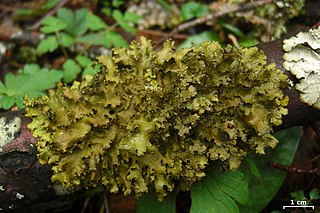
Tuckermannopsis is a genus of foliose lichens in the family Parmeliaceae.

Flavoparmelia is a genus of foliose lichens in the family Parmeliaceae. Because of their appearance, they are commonly known as greenshield lichens. The widely distributed genus contains 32 species. It was circumscribed by American lichenologist Mason Hale in 1986 to contain 17 former Pseudoparmelia species with broad lobes, usnic acid in the cortex, and isolichenan in the cell walls.

Cetrelia is a genus of leafy lichens in the large family Parmeliaceae. They are commonly known as sea-storm lichens, alluding to the wavy appearance of their lobes. The name of the genus, circumscribed in 1968 by the husband and wife lichenologists William and Chicita Culberson, alludes to the former placement of these species in the genera Cetraria and Parmelia.

Punctelia is a genus of foliose lichens belonging to the large family Parmeliaceae. The genus, which contains about 50 species, was segregated from genus Parmelia in 1982. Characteristics that define Punctelia include the presence of hook-like to thread-like conidia, simple rhizines, and point-like pseudocyphellae. It is this last feature that is alluded to in the vernacular names speckled shield lichens or speckleback lichens.

Nephroma is a genus of medium to large foliose lichens. The genus has a widespread distribution. They are sometimes called kidney lichens, named after the characteristic kidney-shaped apothecia that they produce on the lower surface of their lobe tips, which often curl upwards and thus are visible from above. Sterile specimens that do not have apothecia can look somewhat like Melanelia, Peltigera, Platismatia, or Asahinea. Most species grow either on mossy ground or rocks, or on trees.

Lichens are symbiotic organisms made up of multiple species: a fungus, one or more photobionts and sometimes a yeast. They are regularly grouped by their external appearance – a characteristic known as their growth form. This form, which is based on the appearance of vegetative part of the lichen, varies depending on the species and the environmental conditions it faces. Those who study lichens (lichenologists) have described a dozen of these forms: areolate, byssoid, calicioid, cladoniform, crustose, filamentous, foliose, fruticose, gelatinous, leprose, placoidioid and squamulose. Traditionally, crustose (flat), foliose (leafy) and fruticose (shrubby) are considered to be the three main forms. In addition to these more formalised, traditional growth types, there are a handful of informal types named for their resemblance to the lichens of specific genera. These include alectorioid, catapyrenioid, cetrarioid, hypogymnioid, parmelioid and usneoid.
Hypogymnia congesta is a rare species of foliose lichen in the family Parmeliaceae. Found in China, it was formally described as a new species in 2003. The lichen grows on the bark and wood of conifers and bamboo. Hypogymnia congesta has a brown to brownish-grey foliose thallus measuring up to 8 cm (3.1 in) long or broad, with a cartilage-like texture. The lichen is chemically distinct, containing physodic acid and virensic acid; the latter substance is otherwise unknown from genus Hypogymnia.

Punctelia appalachensis, commonly known as the Appalachian speckled shield lichen, is a species of foliose lichen in the family Parmeliaceae. It is found in the eastern United States and eastern Canada. The lichen was first formally described in 1962 by lichenologist William Culberson as a species of Parmelia. He collected the type specimen growing on tree bark in West Virginia, Hildur Krog transferred it to the newly circumscribed genus Punctelia in 1982.

Cetrelia chicitae is a species of foliose lichen in the family Parmeliaceae. It is found in eastern Asia, North America, and Europe, where it grows on mossy rocks and tree trunks.
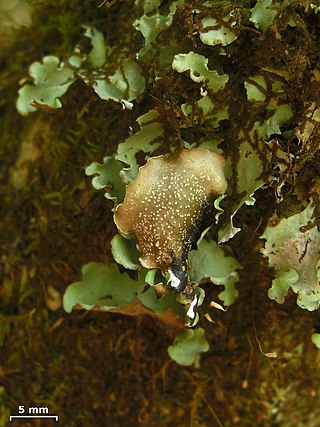
Cetrelia monachorum is a species of foliose lichen in the family Parmeliaceae. It was first described scientifically in 1930 by Alexander Zahlbruckner as a species of Parmelia. Husband and wife lichenologists William and Chicita Culberson transferred it into the genus Cetrelia in 1977. It is found in Asia, Europe, and North America.
Platismatia lacunosa is a species of corticolous (bark-dwelling), foliose lichen in the family Parmeliaceae. Known predominantly from western North America, it was first formally described in 1803 by Erik Acharius. William and Chicita Culberson transferred it to the genus Platismatia in 1968. P. lacunosa was recorded from the Commander Islands in the Russian Far East in 2021.
Platismatia interrupta is a species of foliose lichen in the family Parmeliaceae. Found in southern Russian Far East, and Japan, it was formally described as a new species in 1968 by William and Chicita Culberson. The species epithet interrupta refers to the indistinct and discontinuous reticulation of the upper thallus surface. The lichen of one of the most common foliose macrolichens in Japan, particularly at high elevations, where it grows on tree trunks and on boulders. The authors called it the "Far Eastern equivalent" of the common and widespread Platismatia glauca, which is absent in Asia.
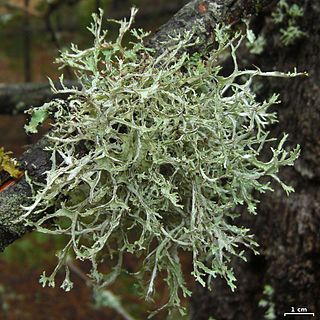
Platismatia stenophylla is a species of corticolous (bark-dwelling), foliose lichen in the family Parmeliaceae. It is found in western North America, from Vancouver Island south to central California, usually close to a shore. It was first formally described as a species of Cetrelia in 1882 by American lichenologist Edward Tuckerman. William and Chicita Culberson transferred it to the genus Platismatia in 1968. The lichen is distinguished from others in its genus by its narrow, linear lobes. It contains caperatic acid and atranorin as lichen products.
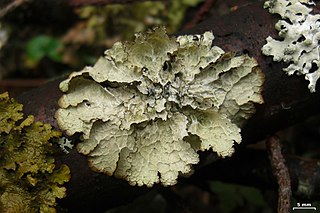
Platismatia tuckermanii is a species of corticolous (bark-dwelling), foliose lichen in the family Parmeliaceae. It was first formally described as a species of Cetraria in 1843 by American botanist William Oakes. The species epithet honours lichenologist Edward Tuckerman, who collected the type specimen in Cambridge, Massachusetts, in 1838. William and Chicita Culberson transferred the taxon to the genus Platismatia in 1968. The lichen is found in Canada and the Southeastern United States. Although usually encountered growing on conifer bark, it is also known to grow on old wooden fenceposts. It contains caperatic acid and atranorin as lichen products.

Platismatia herrei is a species of corticolous (bark-dwelling), foliose lichen in the family Parmeliaceae. It was first formally described as a species of Cetraria in 1968 by lichenologist Henry Imshaug. William and Chicita Culberson transferred it to the genus Platismatia in 1968. The lichen is found in western North America, ranging from southern Alaska to central California. It is distinguished from other members of its genus by the isidia that fringe the edges of its linear lobes; the Culbersons described it as "one of the most beautiful and intricately formed species in the genus".
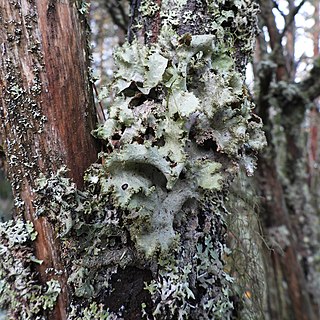
Platismatia glauca is a common and widespread species of corticolous (bark-dwelling), foliose lichen in the family Parmeliaceae.





















